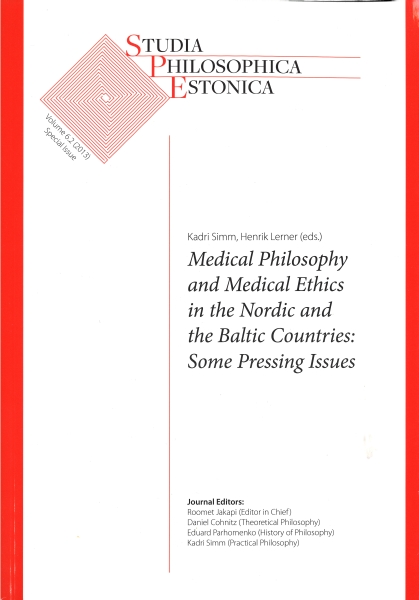Philosophical Roots of the One Medicine Movement: An Analysis of Some Relevant Ideas by Rudolf Virchow and Calvin Schwabe with Their Modern Implications
DOI:
https://doi.org/10.12697/spe.2013.6.2.07Keywords:
one health, one medicine, foundation of, theory of, Virchow, SchwabeAbstract
During the last decade there has been increasing interest in combining veterinary and human medicine, mainly in the areas of vaccination and the eradication of zoonotic and vector-borne diseases. Although the roots of this "One Health-One Medicine" approach can be found in ancient Egypt and Greece, the roots of the philosophy of "one medicine" have not been so thoroughly discussed. In this paper I will analyse some ideas that could unite veterinary and human medicine, from Rudolf Virchow (1821-1902) and Calvin W. Schwabe (1927-2006). Both are recognized as important theoretical founders of the philosophy of one medicine. I will also further develop these thoughts to meet some of the discussions taken place today.
Downloads
References
Battelli, G. and Mantovani, A. (2011). The veterinary profession and one medicine: some considerations, with particular reference to Italy, Veterinaria Italiana 47: 389-395.
Cardiff, R. D., Ward, J. M. and Barthold, S. W. (2008). ‘One medicine-one pathology’: Are veterinary and human pathology prepared?, Laboratory Investigation 88: 18-26.
Cook, R. A., Karesh, W. B. and Osofsky, S. A. (2004). The Manhattan principles on “one world, one health”. retrieved February 1 2013. URL: http://www.oneworldonehealth.org
Day,M. J. (2011). One health: The importance of companion animal vectorborne diseases, Parasites & Vectors 4: 49. URL: http://www.parasitesandvectors.com/content/4/1/49
Dukes, T. W. (2000). That other branch of medicine: An historiography of veterinary medicine from a Canadian perspective, Canadian Bulletin of Medical History 17: 229-243.
Enserink, M. (2007). Initiative aims to merge animal and human health science to benefit both, Science 316: 1553.
Kahn, L.H. (2011). The need for one health degree programs, Infection Ecology and Epidemiology 1.
Kelly, J. (2000). Nutrition of the dairy cow, in A. H. Andrews (ed.), The Health of Dairy Cattle, Blackwell Science, Oxford, pp. 49-88.
Klauder, J. V. (1958). Interrelations of human and veterinary medicine: Discussion of some aspects of comparative dermatology, The New England Journal of Medicine 258: 170-177.
Lerner, H.(2008). The Concepts of Health, Well-being and Welfare as Applied to Animals. A Philosophical Analysis of the Concepts with Regard to the Differences Between Animals, PhD thesis, LinkÖping University.
Lerner, H. (2012). Virchow, in L. Nordenfelt (ed.), Filosofi och medicin. Från Platon till Foucault, Thales, Stockholm, pp. 135-150.
Lerner, H., Lindblad, A., Algers, B. and LynÖe, N. (2011). Veterinary surgeons’ attitudes towards physician-assisted suicide: An empirical study of swedish experts on euthanasia, Journal of Medical Ethics 37: 295-298.
Lund, V. and Röcklinsberg, H. (2001). Outlining a conception of animal welfare for organic farming systems, Journal of Agricultural and Environmental Ethics 14: 391-424.
Mullan, S. and Main, D. (2001). Principles of ethical decision-making in veterinary practice, In Practice 23: 394-401.
Nordenfelt, L. (2006). Animal and Human Health and Welfare: A Comparative Philosophical Analysis, CAB International, Wallingford.
Public Health Agency of Canada. (2009). Report of the expert consultation, One World One Healthâ„¢: From ideas to action, March 16-1 200 Winnipeg, Manitoba, Canada, Public Health of Canada.
Schwabe, C.W. (1978). Cattle, Priests, and Progress in Medicine, Vol. 4 of The Wesley W. Spink Lectures on Comparative Medicine, University of Minnesota Press, Minneapolis.
Schwabe, C. W. (1984). Veterinary Medicine and Human Health, The Williams & Wilkins Company, Baltimore.
Teigen, P. M. (1999). ‘A kindly, useful mentor’: Applying the history of medicine to public policy, Journal of the History of Medicine and Allied Sciences 54: 353-363.
Virchow, R. (1881). An address on the value of pathological experiments, The British Medical Journal 2: 198-203.
Wilkinson, L. (1992). Animals and Disease. An Introduction to the History of Comparative Medicine, Cambridge University Press, Cambridge.
Zinsstag, J., Schelling, E., Waltner-Toews, D. and Tanner, M. (2011). From “one medicine” to “one health” and systemic approaches to health and well-being, Preventive Veterinary Medicine 101: 148-156.

